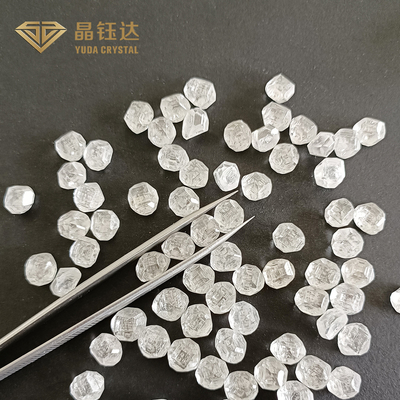Round White DEF Color VVS VS SI Clarity HPHT Rough Diamond For Ring
Lab Grown Diamonds Description
Synthetic techniques of cultured diamond can be divided into high temperature and high pressure method (HTHP) and chemical vapor deposition (CVD).
1) High temperature and high pressure method (HTHP) : the basic principle of HTHP is to simulate the crystallization conditions and growth environment of natural diamond, with graphite powder and metal catalyst powder as the main raw materials, through the hydraulic device to maintain constant ultra-high temperature and high pressure conditions, to synthesize diamond crystals.
At present, high temperature and high pressure (HTHP) method is mainly used in the production of synthetic diamond products in China, which has high growth speed, low cost and poor purity, but has obvious advantages in comprehensive benefits.
2) Chemical vapor deposition (CVD) : The basic principle of CVD is that the mixture of carbon gas and oxygen is excited and decomposed under high temperature and pressure below standard atmospheric pressure to form active diamond carbon atoms, and the active diamond carbon atoms are deposited and grown into diamond single crystals by controlling the deposition and growth conditions.
CVD method has a long cultivation cycle, high cost, secondary color, but high purity.
Parameters Of Lab Grown Diamonds
| Product Name |
Synthetic (Lab created) diamond |
| Material |
Lab-grown |
| Color |
DEF |
| Size |
0.003PCS/CT-7CTS/PC |
| Grade |
VVS VS SI |
| Used |
Jewelry (necklace,ring) |
| Application |
For Cutting Lab Grown Loose Diamonds |
| Place Of Origin |
Zhengzhou, China |
Characteristics Of Lab Grown Diamonds
| The Difference Between Lab Diamond And Natural Diamond |
| Attribute |
Lab Grown Diamonds |
Natural diamond |
Distinction |
| Chemical composition |
C(carbon) |
C(carbon) |
No |
| Refractive index |
2.42 |
2.42 |
No |
| Relative density |
3.52 |
3.52 |
No |
| Dispersion |
0.044 |
0.044 |
No |
| Hardness value |
90 GPA |
90 GPA |
No |
| Thermal conductivity |
2*103 W/M/K |
2*103 W/M/K |
No |
| Thermal property |
0.8*10-6 K |
0.8*10-6 K |
No |
| Light transmittance |
DEEP UV TO FAR TR |
DEEP UV TO FAR TR |
No |
|
Resistivity
|
1016 OHM-CM
|
1016 OHM-CM
|
No
|
|
Compressibility
|
8.3*10-13 M2/N
|
8.3*10-13 M2/N
|
No
|
Lab grown diamonds are exactly the same as natural diamonds, no different.
Cultured diamond (synthetic diamond) is a kind of diamond crystal synthesized by scientific method to simulate the crystallization conditions and growth environment of natural diamond artificially.
Look from the product attributes, foster diamond and natural diamond are crystals of pure carbon, has exactly the same physical, chemical and optical properties, transparency, refractive index, dispersion, etc as natural diamond, in brightness, luster, color, flashing fire completely the same as the natural diamond jewelry features such as cultivation and natural mineral diamonds are real diamonds, Different in nature from the imitation of diamond mossan (carbon silica) and water diamond (cubic zirconia).
In July 2018, the US Federal Trade Commission (FTC) amended the definition of diamond to remove the word "natural" and classify both natural and laboratory diamonds as diamonds.
Lab Grown Diamonds Details


 Your message must be between 20-3,000 characters!
Your message must be between 20-3,000 characters! Please check your E-mail!
Please check your E-mail!  Your message must be between 20-3,000 characters!
Your message must be between 20-3,000 characters! Please check your E-mail!
Please check your E-mail! 







